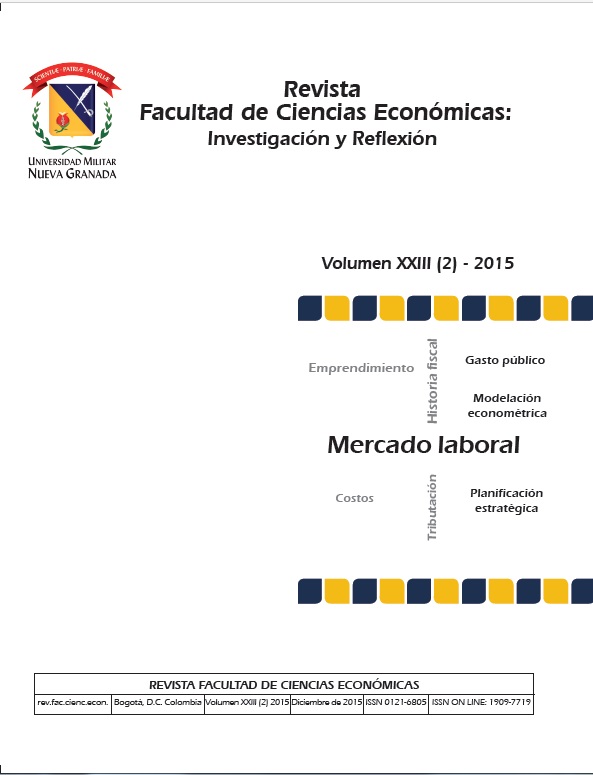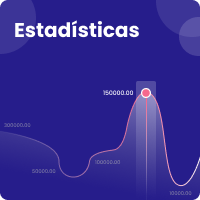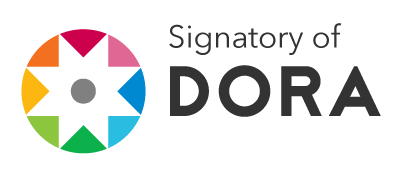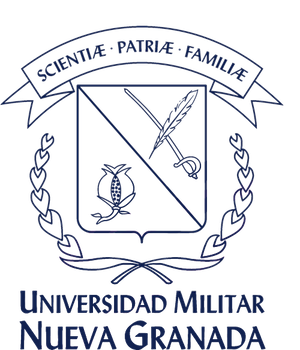Indicadores para la gestión de facultades: un estudio de dos casos en España
Resumen
El objetivo de este artículo es explorar los indicadores para hacer la gestión de dos facultades privadas en España. Se hizo la recolección de datos a través de entrevista, observación directa de los investigadores y análisis de documentos internos de las instituciones de enseñanza. Al final fue posible identificar los indicadores de gestión, financieros y no financieros, de acuerdo con las cuatro perspectivas del Cuadro de Mando Integral (CMI). Se concluye que el caso uno utiliza 34 indicadores, siendo 12 financieros, 10 relacionados con los clientes, 10 de la perspectiva interna y solamente 2 vinculados al desarrollo personal; en el caso dos, se utilizan 41 indicadores, siendo 10 financieros, 11 de los clientes, 11 de los procesos internos y 9 relacionados con el desarrollo personal. Estos resultados están en línea con los resultados obtenidos en otras investigaciones de nivel internacional.Descargas
Lenguajes:
porReferencias bibliográficas
Banker, D., Chang, H. & Pizzini, J. (2004). “The Balanced Scorecard: Judgmental Effects of Performance Measures Linked to Strategy”. The Accounting Review; 79(1), 1 - 23.
Barnabé, F. & Riccaboni, A. (2007). Which role for performance measurement systems in higher education? Focus on quality assurance in Italy. Studies in Educational Evaluation, 33 (3-4), 302-319.
Beard, D. (2009). Successful applications of the balanced scorecard in higher education. J. Educ. Bus., 84, 275-282. DOI: 10.3200/JOEB.84.5.275- 282
Canic, M.J., & Mccarthy, P.M. (2000). “Service Quality and Highter Education do Mix: A Case Study”. Quality Progress, 33(09), 41-46.
Chang, O. H. & Chow, C. W. (1999). “The Balanced Scorecard: A Potential Tool for Supporting Change and Continuous Improvement in Accounting Education”. Issues in Accounting Education, 14(3), 395-412.
Chen, S-H; Yang C-C. & Shiau, J-Y, (2006). “The application of balanced scorecard in the performance evaluation of higher education”. The TQM Magazine, 18(2), 190-205.
Chenhall, R. H. (2008). Accounting for the horizontal organization: A review essay. Accounting, Organizations and Society, 33, 517–550
Currie, J. & Newson, J. (1998). Universities and Globalization: Critical Perspectives. Thousand Oaks: Sage Publications.
Craig, D. S., Gholson, B. & Driscoll, D. M. (2002). "Animated Pedagogical Agents in Multimedia Educational Environments". Journal of Educational Psychology, 94(2), 428-434.
Edwards, N., Hugo, K., Gragg, B. & Peterson, J. (1999). The Integration of Problem-Based Learning Strategies in Distance Education. Nurse Educator, 24(1), 36-41.
Eisenhardt, K. M. ( 1989). Building Theories from Case Study Research. Academy of Management. The Academy of Management Review, 14(4), 532-549.
Farid, D. N. & Mehran, M. H. (2008): “Balanced scorecard application in universities and higher education institutes: Implementation guide in an iranian context”. Annals of University of Bucharest, Economic and Administrative, Series, 2,. 31-45
Guolla, M. (1999). “Assessing the Teaching Quality to Student Satisfaction Relationship: Applied Customer Satisfaction Research in the Classroom”. J. Mark. Theory Pract., 7(3), 87-97.
Hyland, G. J. (2000). Physics and biology of móbile telephony. The Lancet, 356, 1-8.
Hodson, P. & Thomas, H. (2003). Quality assurance in higher education: fit for the new millennium or simple year 2000 compliant? Higher Education, XLV, 375-387. Netherlands: Kluwer Academic Publishers.
Kaplan, R.S. & Norton, D.P. (1992): The balanced scorecard – Measures that drive performance, Harvard Business Review, janeiro-fevereiro de 1992.
Kaplan, R.S. & Norton, D.P. (1996a) Putting the balanced scorecard to work. Boston: Havard Business School Press.
Kaplan, R.S. & Norton, D.P. (1996b) The balanced scorecard. Boston: Havard Business School Press.
Kaplan, R.S. & Norton, D.P. (1997a) The balanced scorecard – translating strategy into action. Boston: Havard Business School Press.
Kaplan, R.S. & Norton, D.P. (1997b) A Estratégia em ação: balanced scorecard. Rio de Janeiro: Campus.
Kaplan, R.S. & Norton, D.P. (1998) Linking the balanced scorecard to strategy. Disponível em: <http://www.hbsp.harvard.edu/hbsp/prod_detail.asp?cmr073.html>. Acesso em: 26 mai O.
Kaplan, R.S. y Norton, D.P. (2000a) Having trouble with your strategy? Then map it. Boston: Havard Business School Press.
Kaplan, R.S.& Norton, D.P. (2000b) Organização orientada para a estratégia: como as empresas que adotam o balanced scorecard prosperam no novo ambiente de negócios. Rio de Janeiro: Campus,
Kaplan, R.S. & Norton, D.P. (2001) David P. Organização Orientada para a Estratégia. 4o ed. Rio de Janeiro: Campus, 411p.
Kaplan, R.S. y Norton, D.P. (2004) Mapas estratégicos: convertendo ativos intangíveis en resultados tangíveis. 6. ed. Rio de Janeiro: Campos.
Karathanos, D. & Karathanos, P. (2005). “Applying the Balanced Scorecard to Education”. Journal of Education for Business, 80(4), 222-230.
Kelm, M. L. (2003). Indicadores De Performance Em Instituições Universitárias Autogeridas – Uma Contribuição À Gestão Por Resultados, Tese de Doutorado, UFSC - Florianópolis – Brasil.
King, R. (1995). What is higher education for? Strategic dilemmas for the twenty-first century university. Quality Assurance in Education, 3(4), 14-20.
Kozlowski, O., Pollez, B., Thevenon, A., Dhellemmes, P. & Rousseaux, M. (2002). Devenir et qualité de vie à trois ans dans une patients traumatisés crâniens graves. Ann Readap Med Phys, 45, 466-73.
Lawrence, S. & Sharma, U. (2002). “Commodification of Education and Academic Labour Using the Balanced Scorecard in a University Setting”. Critical Perspectives on Accounting, 13, 661-677.
Martins, G de A. (2008): Estudo de Caso – uma estratégia de pesquisa. São Paulo, 2ª edição. Ed. Atlas.
Mavondo, F. T., Tsarenko, Y. & Gabbott, M. (2004). “International and Local Student Satisfaction: Resources and Capabilities Perspective”. J. Mark. High. Educ.., 14(1), 41-60.
Marzo, M., Pedraja, M. & Rivera, M. P. (2005). “Measuring Customer Satisfaction in Summer Courses”. Qual. Assur. Educ., 13(1), 53-65.
Modell, S. (2005), Triangulation between case study and Surrey methods in Management accounting research: an assessment of validity implications. Management Accounting Research, 16, 231-254.
Neumann, R. & Guthrie, J. (2002). “The corporatisation of research in Australian higher education”. Critical Perspectives on Accounting, 13, 721-41.
O'neill, J. (2003). Meta-ethics. A companion to environmental philosophy. D. Jamieson. Malden, Blackwell.
Papenhausen, C. & Einstein, W. (2006). Implementing the Balanced Scorecard at a college business. Measuring Business Excellence, 10(6), 15-22.
Ruben, B. D. (2004), “Pursuing Excellence in Higher Education: Eight Fundamental Challenges”, Jossey-Bass, San Francisco, CA.
Ryan, B.; Scapens, R.W. & Theobald, M. ( 2004): Metodología de la investigación en Finanzas y Contabilidad. Barcelona: Deusto.
Scapens, R.W. (1990). Research into management accounting practices. Management Accounting, 66(1),.26-28.
Scapens, R.W. (1994) Never mind the gap: towards an institutional perspective on management accounting practice. Management Accounting Research, 5, 301-321.
Schertzer, C. B. & Schertzer, S. M. B. (2004). “Student Satisfaction and Retention: A Conceptual Model”. J. Mark. High. Educ., 14(1), 79-91.
Stake, R.E. ( 1995): The art o f case study research, Thousand Oaks, CA: Sage Publications.
Storey, A. (2002). “Performance management in schools: could balanced scorecard help? School Leadership and Management, 22(1), 53-63.
Tayler, W. B. (2010) The Balanced Scorecard as a Strategy-Evaluation Tool: The Effects of Implementation Involvement and a Causal-Chain Focus. THE ACCOUNTING REVIEW American Accounting Association, 85(3). DOI: 10.2308/accr.2010.85.3.1095. pp.1095–1117.
Tariq, I. (2007). “Performance evaluation measures in the private sector: Egyptian practice”. Managerial Auditing Journal. Bradford: Tomo 22, 5.
Tinker, T. & Koutsoumadi, A. (1997). “A Mind is a Wonderful Thing to Waste: Think like a Commodity, Become a CPA”, Accounting,
Auditing & Accountability Journal, Vol. 10, No. 3, pp. 454-467.
Vavio, J. (2008). “Qualitative management accounting research: rationale, pitfalls and potential”. Qualitative Research in Accounting & Management, 5(1), 64-86.
Venkatesh, U. & Kirti, D. (2007). “Balanced scorecards in managing higher education institutions: an Indian perspective”. The International Journal of Educational Management. Bradford: Tomo 21, 1.
Wiers, J., Stensaker, B. & Grogaard, J. B. (2002). “Student Satisfaction: Towards an Empirical Deconstruction of the Concept”. Qual. High. Educ., 8(2), 183-195.
Woodside, A. G. & Wilson, E. J. (2003). “Case Study Research for Theory-Building. Journal of Business & Industrial Marketing, 18(6/7), 493-508.
Yin, R. K. (1994). Case study research: design and methods (2nd ed.). Thousand Oaks, Calif: Sage.
Yin, R. K. (2005) Estudo de Caso: Planejamento e Métodos. Ed. Bookman. 3ª ed.
Zeithaml, V. A., Berry, L. L. & Parasuraman, A. (1993). “The Nature and Determinants of Customer Expectations of Services”. J. Acad. Mark. Sci., 21(1), 1-12.












